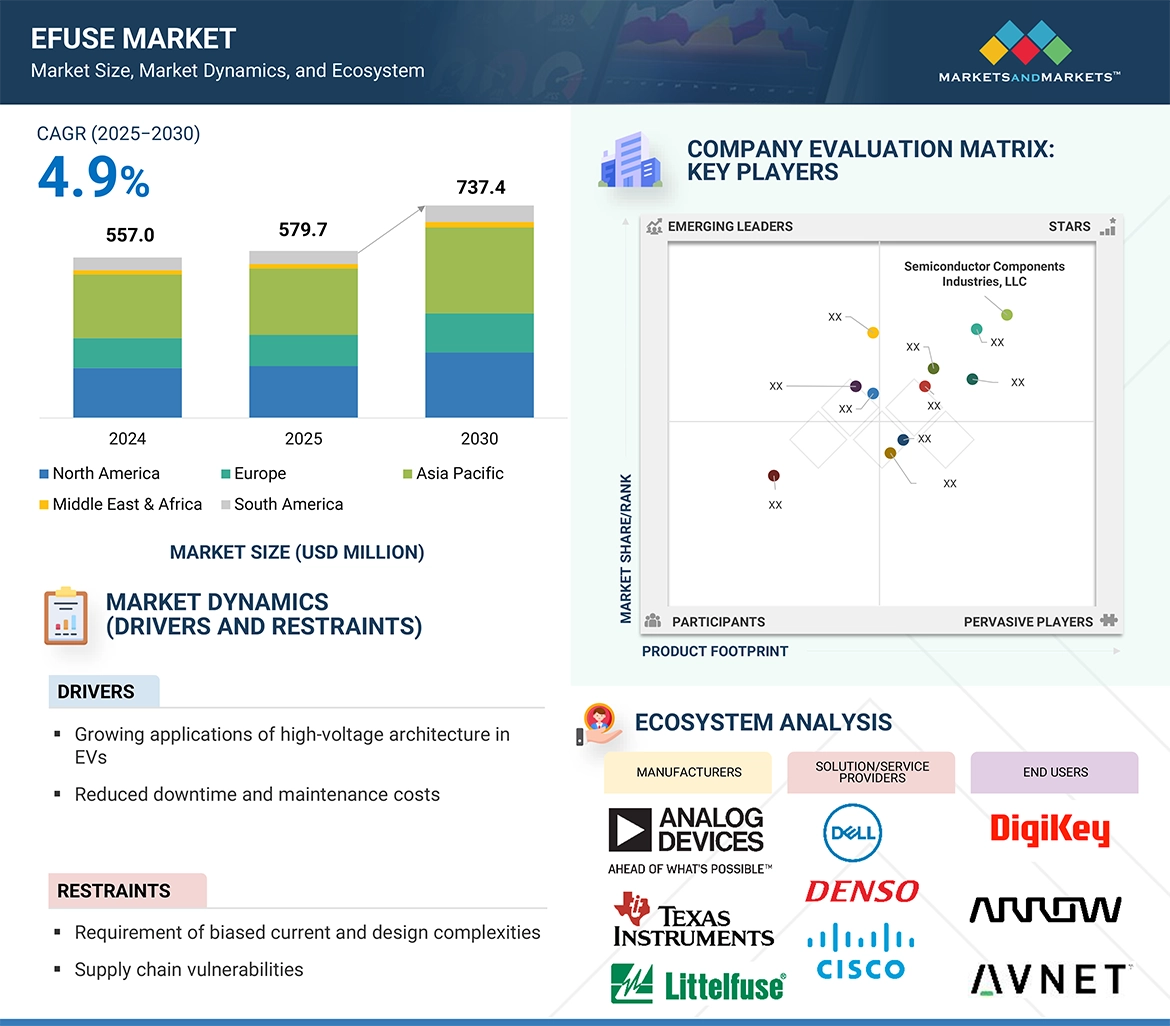The eFuse Market is projected to reach USD 737.4 million by 2030 from an estimated USD 557.0 million in 2024, at a CAGR of 4.9% during the forecast period.
Growth in the eFuse market is being accelerated by more challenging electronic systems and higher demands for reliable protection in automotive, data center, and consumer devices. Because advanced eFuse technologies are small, accurate in current limitation, and can diagnose themselves, more are being used. It ensures that high-power systems are safe, work efficiently, and maintain proper temperatures. By using WBG semiconductors, companies are able to develop faster and more energy-efficient supply chain solutions. Using technologies makes it easier to prevent the damage caused by circuits. Improved eFuse solutions can be added to the battery management system of electric vehicles (EVs), so overcurrent and overheating are detected and dealt with quickly. Circuit protection has improved in various sectors after the introduction of eFuses. eFuses supports real-time detection of faults and effective handling of electricity because of improved technology. As a result, the system can handle overcurrent, overvoltage, and temperature issues smoothly. This means that eFuses in automotive use can deliver exact current restriction and fast fault finding, which is suitable for electric vehicles. This helps manufacturers ensure safety, reduce moments when things break down, and reduce power consumption in important and reliable systems.
Download PDF Brochure – https://www.marketsandmarkets.com/pdfdownloadNew.asp?id=157236196
Thin shrink small outline package, by application
Many electronics use eFuses in TSSOP packages because they are compact. It is an excellent solution for applications in automobiles, telecoms, and personal electronics, given that cooling and dependability are very important. If any issue related to fast faults is found, the system imposes a high current control and it can stop to avoid overheating. Thanks to TSSOP eFuses, the system remains safe even when it is exposed to high currents and voltages. What is more, their function supports quick fault detection, so the system responds immediately if a fault occurs within the circuit, which keeps it working well at all times. TSSOP allows manufacturers to efficiently manage power flow, and therefore, eFuses are chosen for modern, advanced electronic devices due to their ability to solve thermal issues.

Auto retry, by type
Auto Retry, by type, is anticipated to maintain strong growth momentum during the forecast period in the eFuse market. eFuses are categorized into two types: auto retry and latched. The increasing adoption of auto retry eFuses stems from their ability to automatically reset after a fault is detected, ensuring continuous operation in critical systems. It results in less downtime and better reliability, which is why auto retry eFuses are preferred for use in automotive electronics, industrial systems, and data centers. Due to a focus on keeping systems running and tolerating faults, auto retry eFuse sales are predicted to increase a lot. Many industries are starting to use auto retry eFuse technologies to guarantee effective results and cut down on the work needed for upkeep in crucial electronics.
Regional Analysis
During the forecast period, Asia Pacific is expected to be the fastest-growing region in the eFuse market. There is strong demand for eFuses in Asia, fueled by government action and investments to update power grids to cope with huge electricity use. China, Japan, and India have begun many grid expansion efforts, helping to increase reliability and leading to more eFuses being adopted in the region.
Ask Sample Pages of the Report – https://www.marketsandmarkets.com/requestsampleNew.asp?id=157236196
Key Market Players
Some of the major players in the eFuse market are Littelfuse, Inc. (US), TOSHIBA ELECTRONIC DEVICES & STORAGE CORPORATION (Japan), Semiconductor Components Industries, LLC (US), and Texas Instruments Incorporated. (US), and Alpha and Omega Semiconductor. (US). The major strategies adopted by these players include acquisitions, product launches, agreements, partnerships, and expansions.

